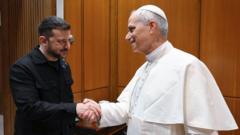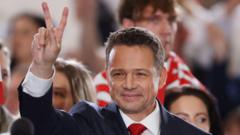The papal conclave began its second day of voting on Thursday, as cardinals aim for a two-thirds majority decision for a new pope. The process, marked by secrecy and the absence of technology, reflects tensions between progressive and conservative factions within the Church following Pope Francis' death. The conclave's duration remains uncertain as cardinals navigate unfamiliar politics and relationships.
Papal Conclave Continues into Second Day of Voting

Papal Conclave Continues into Second Day of Voting
The Vatican conclave enters its second day of voting as cardinals seek to elect the next pope amidst unprecedented dynamics and challenges facing the Roman Catholic Church.
The papal conclave has now resumed its activities for a second day, as the 133 cardinals continue their deliberations to select the successor of Pope Francis. Wednesday's initial voting rounds ended without a decision, compelling the assembly to reconvene in the Sistine Chapel under oaths of secrecy and without outside communication—no phones, internet, or media are permitted during the voting process.
This conclave holds historical significance, being the first in over a decade, triggered by the death of Pope Francis in April. Uncertainty looms over the future of the Catholic Church, now navigating through financial strains, controversies over past sexual abuse scandals, and a need for modernization to engage with its 1.4 billion faithful.
The proceedings are decidedly different this time, as many cardinals present were appointed by Francis and may be unfamiliar with their colleagues. This scenario has led to speculation that the electing process could be more complex and drawn out than in previous conclaves, often characterized by swift decision-making. The routine of casting votes continues today with intentions for two rounds of voting in both the morning and afternoon, potentially leading to smoke signals indicating the outcome. Black smoke will signal no decision, while white will announce the election of a new pope.
Prominent contenders for the papacy include Cardinal Pietro Parolin, a former right-hand man to Francis, and Cardinal Luis Antonio Tagle, known for embracing more liberal perspectives. The crux of the decision will likely reflect whether cardinals choose to continue a path of greater openness akin to Francis or seek a return to traditional conservativism.
Meanwhile, the atmosphere in St. Peter's Square reflects a mix of anticipation and patience as crowds gather awaiting news, alongside tours focused more on visiting a historical site than reengaging with a faith in transition. Cardinal Timothy M. Dolan expressed concerns, suggesting the selection may take longer than previous instances, reflecting the need to reach a consensus among unfamiliar peers.
The semiclassical voting rituals and rigorous adherence to secrecy harken back to centuries of tradition, ensuring only the cardinal electors participate in the process in a highly controlled environment. Data suggested that while previous conclaves like Francis' election in 2013 took merely two days, this time could unfold differently given the scholars' interpretations surrounding the tensions and opportunities present within cardinal electors.
Overall, as Vatican leaders enter the second day of secret ballots and prayers, the world watches closely, eager to learn how the Catholic Church's next chapter will be shaped.
This conclave holds historical significance, being the first in over a decade, triggered by the death of Pope Francis in April. Uncertainty looms over the future of the Catholic Church, now navigating through financial strains, controversies over past sexual abuse scandals, and a need for modernization to engage with its 1.4 billion faithful.
The proceedings are decidedly different this time, as many cardinals present were appointed by Francis and may be unfamiliar with their colleagues. This scenario has led to speculation that the electing process could be more complex and drawn out than in previous conclaves, often characterized by swift decision-making. The routine of casting votes continues today with intentions for two rounds of voting in both the morning and afternoon, potentially leading to smoke signals indicating the outcome. Black smoke will signal no decision, while white will announce the election of a new pope.
Prominent contenders for the papacy include Cardinal Pietro Parolin, a former right-hand man to Francis, and Cardinal Luis Antonio Tagle, known for embracing more liberal perspectives. The crux of the decision will likely reflect whether cardinals choose to continue a path of greater openness akin to Francis or seek a return to traditional conservativism.
Meanwhile, the atmosphere in St. Peter's Square reflects a mix of anticipation and patience as crowds gather awaiting news, alongside tours focused more on visiting a historical site than reengaging with a faith in transition. Cardinal Timothy M. Dolan expressed concerns, suggesting the selection may take longer than previous instances, reflecting the need to reach a consensus among unfamiliar peers.
The semiclassical voting rituals and rigorous adherence to secrecy harken back to centuries of tradition, ensuring only the cardinal electors participate in the process in a highly controlled environment. Data suggested that while previous conclaves like Francis' election in 2013 took merely two days, this time could unfold differently given the scholars' interpretations surrounding the tensions and opportunities present within cardinal electors.
Overall, as Vatican leaders enter the second day of secret ballots and prayers, the world watches closely, eager to learn how the Catholic Church's next chapter will be shaped.




















